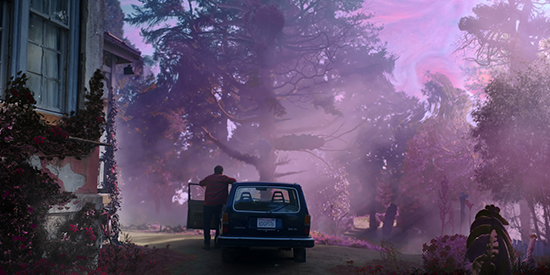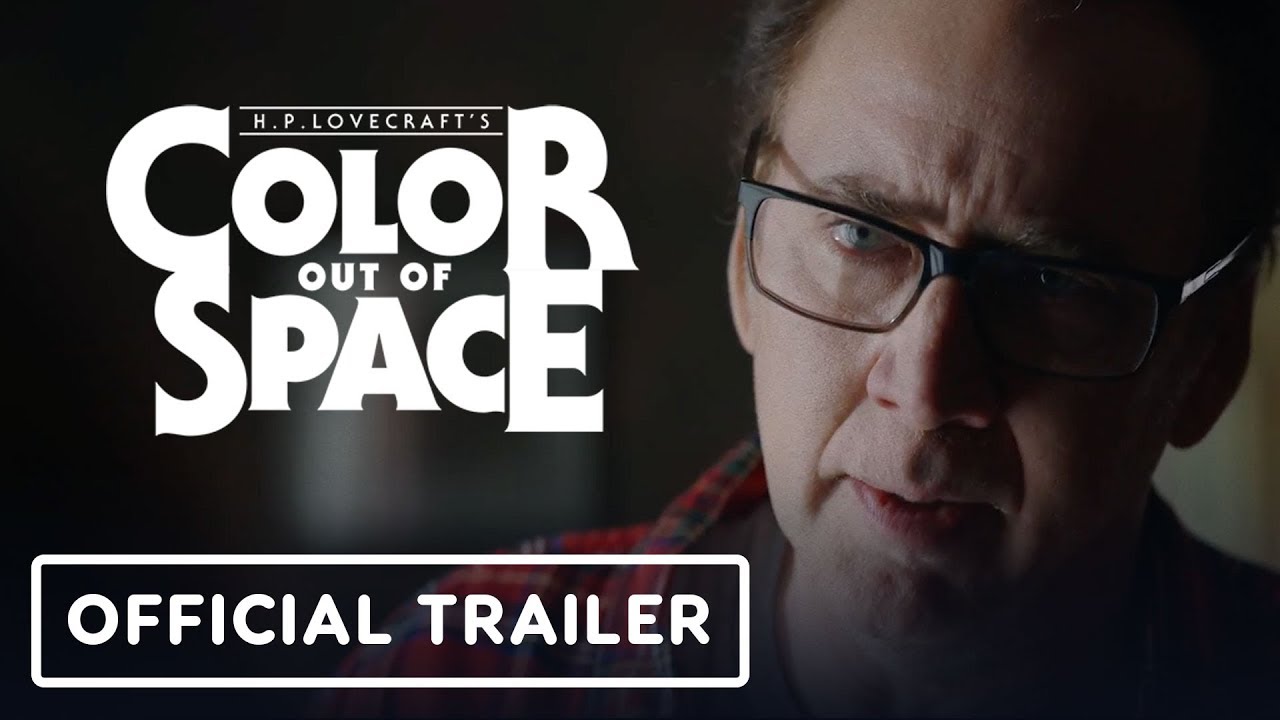After a 10-year hiatus, director Richard Stanley returns with Color Out Of Space, a technicolor nightmare-scape based on a short story by horror author HP Lovecraft. Stanley takes the 19th-century work, one written with scientific detachment, and creates an intensely emotional narrative fit for 21st-century horror cinema. A colour, unable to be classified or defined, has consumed the very thoughts of a family who have descended onto an ancestral land as a respite from the city. Madness descends, alpacas abound – and questions are asked about what it means to adapt the work of an author with a racist past.
The Colour Out Of Space was a short story initially published in 1927 by Lovecraft. It follows a land surveyor investigating a blasted heath in Arkham, Massachusetts. It’s revealed that an asteroid crashed down onto the Gardner family farm and is warping the landscape, and eventually the Gardners themselves. Lovecraft is known for his tales of nihilism and doom, with unknowable creatures from other dimensions shattering humanity’s notion of existence. His work is often poignant and devastating. But it is also deeply troubling in Lovecraft’s depictions of people of colour, often calling them racial slurs and characterizing them as savages. He was also anti-Semitic and praised Hitler. He was terrified of women and often portrayed them as monsters, when he did at all. His politics are intertwined with his writing; there is no way to divorce his beliefs and his work.
So how can Stanley adapt such an author’s work? With Lovecraft’s well-known racist past, what does it mean to continue adapting his work? In an interview with Dread Central, Stanley addressed the author’s issues of race, stating:
“I think Lovecraft’s racism is his dislike for the human race on the whole. In a way it’s part of his hatred of life. I think he has mistrust of anyone who is enjoying themselves too much; life is such a terrible thing, surely if you are enjoying it too much there must be something wrong, something off about you too. I would recommend a more careful approach to reading his material but on some level, he is the American Kafka; it doesn’t rob him of the fact that he is still a major figure to be dealt with.”
It is a frustratingly diplomatic answer. Stanley is placing Lovecraft’s racist beliefs in a wider context where he seems to excuse such behavior as hating everyone. Yes, the writer was nihilistic and angry, but that does not excuse horrific declarations about an entire race. But the end of Stanley’s quote does open up the broader discussion of the author’s influence on the horror genre. Lovecraft is a major figure in English literature and shaped the horror genre. So where do we go from there?
Perhaps, then, it is important to look at how Stanley’s film reflects a contemporary, diverse worldview adaptation that actively works against Lovecraft’s own personal viewpoints. Color Out Of Space is a much more personal and emotional piece of work, with the film focusing on the Gardner family before, during, and after the colour appears. The audience is invested in their story and how they slowly disintegrate—both literally and figuratively—into the ether. It is no longer a detached narrative, written like a scientific study with the Gardners as the subjects. Emphasis is placed on the daughter, Lavinia, as she tries to understand what is happening to her family through the lens of witchcraft. She becomes the main protagonist as the audience primarily follows her during the family’s spiral into hell. The feminine is imbued in the film, rejecting Lovecraft’s own misogyny.
Most importantly, Stanley casts people of colour as main characters, namely Q’orianka Kilcher as Mayor Tooma and Elliot Knight as Ward, the surveyor who is observing what is unfolding on the farm. Ward takes the place of Lovecraft’s first-person narrator, therefore taking the place of the writer himself. A Black man is placed in the position that Lovecraft had created for himself – a deliberate stance taken against the writer’s politics. Stanley is reclaiming Lovecrat’s previous narrative and trying to make it something else, transforming it like the eponymous colour does to the farm.
Color Out Of Space shares the name of a Lovecraft story, and that IP cannot be ignored. But what would it have meant for Stanley to push the narrative just a step further to create something new, something that could be labelled more broadly and remove the importance from a racist past? Lovecraft, while influential in creating a subgenre, was not the only artist working within the concepts of cosmic horror. Other monsters have been created other than Cthulhu and the pantheon of Elder Gods. There are countless examples of cosmic horror that do not share a name with a Lovecraftian work that depict similar themes of incomprehensibility, madness, and the great unknown. Alex Garland’s Annihilation deals with similar subject matter, as an asteroid crashes into Earth and alters the land around it. A group of five women trudge into the changing landscape and discover a new reality that cannot be truly comprehended by the human mind. It is not just a story about aliens, but about grief, guilt, and knowing what it means to truly be human—all themes seen in the subgenre. Lovecraft’s influence can be seen, but ultimately Garland, and the author of the source material Jeff VanderMeer, created something unique in the subgenre of cosmic horror. Other examples include A.T. White’s Starfish, Justin Benson and Aaron Moorhead’s The Endless, and Frank Darabont’s The Mist.
In looking at the landscape of contemporary horror cinema, there is no easy answer to the question of what role such an artist plays in the art world after their death. Perhaps there is no one answer at all. But it remains crucial going forward to acknowledge the context of source material, and give it a contemporary twist that actively works against its harried past. With Color Out Of Space, Stanley has worked to create something original from the past, while still updating it to reflect a more inclusive present. But now it is time to move towards the larger label of cosmic horror, placing emphasis not on the individual man, but on the feelings created by a subgenre tackled by numerous writers of different genders and races. While Lovecraft was writing within that subgenre and remains an influential figure, it is time to take away such awesome power from one white man. It is time instead to recognize those who are innovating, creating nihilistic, incomprehensible worlds that capture the mind-numbing madness of the contemporary world. No longer does an angry man from 1926 hold the keys to a world of monsters, ghouls, and gods.



